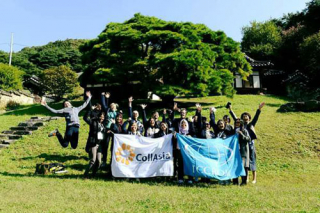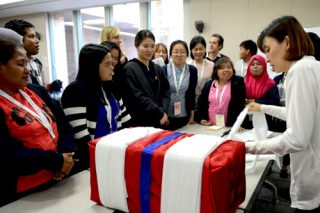The National Research Institute of Cultural Heritage (NRICH) of Korea hosted the international ICCROM CollAsia course on Packing and Storing Objects and Collections – Tradition and Modernity in Daejeon, Republic of Korea, from 11 – 25 October 2017. The course, one outcome of a five-year agreement (2012-2017) between the Korean Cultural Heritage Administration (CHA) and ICCROM, involved 24 professionals from 16 countries with different backgrounds in heritage conservation.
The challenge of packing and storing movable collections was the focus of the two-week course. The objective was to develop a shared understanding by identifying core functions in order to make effective choices of methods and materials. Interactive learning modalities, which have become a distinctive feature of the CollAsia programme, were used throughout. A didactic collection of diverse objects, together with different packing and storing materials, provided concrete learning opportunities and a basis for small-group exercises. Participants were challenged to discuss strengths and weaknesses of different packing and storing materials, techniques and procedures, in relation to different scenarios.
Lectures by the teaching team introduced ways to identify risks related to packing and storing, suitable materials to respond to those risks, and how to take effective and sustainable decisions for the preservation and use of collections. Participants explored changes in cultural values and material properties, recognizing the vulnerabilities of heritage objects to different situations. Exercises were developed to underline the principles behind the topics discussed. These broad issues could vary from the impacts of the environment on collection management to the importance of documentation for tracking objects in different circumstances. The participants were challenged to think systemically, in order to understand changes in both material properties and values, both in objects and in the enclosures around them. Packing and storing were always considered as responses to specific institutional functions.
Study visits and demonstrations helped to build bridges between tangible and intangible heritage and to stress the connection between movable and immovable heritage. The use of traditional paulownia boxes in both Korea and Japan and the packing of ‘ham’, the traditional Korean wedding box, showed the complex relation between objects and containers. This relation was also considered on a bigger scale via study visits to traditional Korean houses at the Youheodang village, and to the National Palace Museum and the National University of Cultural Heritage (NUCH) in Seoul.
The classroom sessions alternated small-group exercises with plenary discussions and case studies in order to provide examples of both day-to-day work and applied research. Further examples were provided by the pictures and presentations that the participants brought from their own institutions. The incredible variety of challenges and possible solutions presented showed the benefits of locally available traditional materials and techniques, when these are applied to respond to specific functions and not to fixed ‘recipes’.
The participants were encouraged to build knowledge together through a series of sessions dedicated to formulating collaborative research proposals. The aim was to stress the importance of arriving at clear and precise research questions in order to respond to specific challenges related to packing and storing. Such research collaboration can help to build long-term perspectives for the collections and the people working with them. This approach, which constituted the ‘red thread’ running through the entire course, can help in expanding professional perspectives and skills in a concrete way. Professionals are challenged to develop their critical thinking skills in order to identify questions, problems and effective responses, and to learn how to communicate them. The unique opportunity to share interactive learning experiences with colleagues from different countries and different backgrounds, a standard feature of CollAsia courses, increases the learning potentialities and opens windows for further collaborative projects.
CollAsia is an important activity of ICCROM. It is an educational program aiming to improve conditions for the conservation of movable heritage collections in Southeast Asian countries. CollAsia focuses on continuous professional development activities (CPD).
CollAsia was developed at the request of Member States of ICCROM. In 2003, ICCROM and the Southeast Asian Ministers of Education Organization Regional Centre for Archaeology and Fine Arts, widely known as SEAMEO-SPAFA, launched the CollAsia program to improve conservation conditions for Southeast Asian collections. The program had the financial support of the Getty Foundation. Since 2012, CollAsia has continued thanks to the generous support of the Korean Cultural Heritage Administration, which provides ICCROM with the core founding for ongoing CollAsia activities.
Member States represented: Bangladesh, Brazil, Cambodia, India, Indonesia, Italy, Japan, Republic of Korea, Lao PDR, Malaysia, Myanmar, Philippines, Thailand, United Kingdom and Vietnam.
Non-Member State: Timor-Leste




